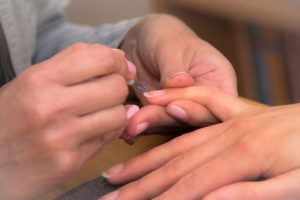
Your body has the amazing ability to offer insight into your health. So, the next time you’re concerned about your body, take a quick look at your fingernails.
Besides acting as a solid foundation for your next manicure, strong, healthy finger nails are often an indicator of good health.
On the flip side, weak, brittle, and discolored nails can be a major red flag that something is not functioning properly inside your body.
Keep reading to discover 6 things your fingernails can tell you about your health.
#1 Discolored Nails
For many people, nail color changes with age. Most commonly, nails become tinted with a yellow hue. This is nothing to worry about.
If you notice a drastic change in nail color, typically from a healthy natural shade to a deep yellow color, your body may be struggling. One of two things might be happening.
First, your body is probably not getting the nutrients it needs to produce healthy cells that, in return, create healthy-looking nails.
Try adding more fruits and vegetables into your diet to ensure you’re getting all the essential vitamins and nutrients you need.
Second, your body could be suffering from the effects of exposure to harmful chemicals. The most common causes of this exposure come from smoking or using harsh chemical-based nail products.
The solution: quit smoking, and take a break from using nail products so your nails have a chance to heal.
#2 Clubbing
Nail clubbing occurs when the ends of your nails become curved and rounded.
Symptoms of nail clubbing include:
- Fluctuation and softening of the nail bed.
- Loss of the normal <165° angle between the nail bed and the fold (cuticula).
- Increased convexity of the nail fold.
- Thickening of the whole distal (end part of the) fingernail (resembling a drumstick).
- Shiny aspect and striation of the nail and skin.
If you notice any of these symptoms, please immediately seek medical help. This could be a sign of kidney disease, which needs to be treated professionally.
#3 White Spots
Most often, white spots on nails are caused by minor trauma, such as hitting your nail bed on a table. It’s truly nothing to be concerned about.
However, if you notice large collections of white spots that suddenly appear on your nails, it might be due to a lack of calcium in your diet. Not to worry.
This problem is easily solvable. Talk to your doctor about adding a natural calcium supplement into your diet.
#4 Spoon Nails
Spoon nails, also known as Koilonychia, is a condition that causes a depression in your nail bed. This depression causes your fingers to look like little spoons.
If you notice your nail beds sinking in, it could be a sign of an iron deficiency.
To fix the problem, add more iron-rich foods into your diet, or have your doctor recommend an iron supplement.
In more severe cases, spoon nails can be an indication of musculoskeletal and kidney abnormalities. If you are concerned, please seek medical attention from your doctor immediately.
#5 Pitted Nails
Depressions, dents, and cracks in your nail beds are known as pitted nails.
Most often pitted nails are associated with psoriasis, an inflammatory disease that leads to scaly or red patches all over the body.
If you notice your nails are pitted, let your doctor know.
A quick examination is all it takes to diagnose psoriasis and get you on the road to recovery. Topical, oral, injected medications or light therapy can be used to fix the problem.
#6 Blue Nails
Blue nails, another form of nail discoloration, is a major red flag that your fingertips are not getting enough oxygen. This is commonly caused by respiratory disease and/or a vascular problem.
If your nails turn blue, it’s a good idea to have the oxygen levels in your blood tested.
This can easily be done at your doctor’s office.
Keep your nails, and the rest of your body, happy and healthy by consuming smoothies packed with the nutrition you need. Check out the recipes here.

